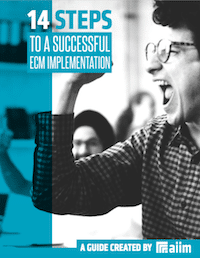The AIIM Blog
Keep your finger on the pulse of Intelligent Information Management with industry news, trends, and best practices.
Enterprise Content Management (ECM) | Project Planning and Management
Making an ECM implementation work requires planning and attention to detail. At first blush, it may look like any other technology implementation, but it's far from it. ECM is a complex set of technologies that work together. The best way to create the right solution is to identify organizational goals and priorities. Common drivers include enabling easy access and retrieval of content, as well as, reducing risk and meeting regulatory requirements. I recently put together a short white paper outlining the 14 steps to a successful ECM implementation. I've compiled the finer points into a checklist, designed to help guide your organization through the process of implementing ECM.
Share
Enterprise Content Management (ECM)
I recently had a conversation with outgoing AIIM board member Michael Croal (Cornerstone Advisors). I thought I would capture the core of it in this blog post. I think there is a lot of meat here regarding the industry and how we sell and position content-centric solutions.
Share

Making an ECM implementation successful requires planning and attention to detail. The best way to create the right solution is to identify organizational goals and priorities. Learn how to manage a successful implementation in our free guide.
Electronic Records Management (ERM) | Enterprise Content Management (ECM)
In this series of interviews, we've been chatting with The AIIM Conference sponsors to get a preview of their upcoming sessions. Here, I sat down with Brian Tuemmler from Nuix. We explore some of the shortcomings of Enterprise Content Management (ECM) systems and implementations. Brian talks about some clever new ways to approach ECM and how Nuix can help. What's in Your ECRM System? Brian Tuemmler is an Information Governance Program Architect with Nuix.
Share
Digital Transformation | Enterprise Content Management (ECM) | Intelligent Information Management (IIM)
As we start to think about #AIIM15, I thought I would ask a number of our sponsors a few identical questions in order to get an understanding of how they see the future of our industry -- and let those of you attending start to think about your own questions to ask them in San Diego. Here are the three questions I'll ask: What are the three biggest challenges you see your customers facing while trying to “Embrace the Chaos”? What do you see as the three most important trends related to Information Management facing organizations over the next 18-24 months? What will be different in our industry two years from now? What are the three most important things attendees should know about your company?
Share
Enterprise Content Management (ECM)
As we start to think about #AIIM15, I thought I would ask a number of our sponsors a few identical questions in order to get an understanding of how they see the future of our industry -- and let those of you attending start to think about your own questions to ask them in San Diego. Here are the three questions I'll ask: What are the three biggest challenges you see your customers facing while trying to “Embrace the Chaos”? What do you see as the three most important trends related to Information Management facing organizations over the next 18-24 months? What will be different in our industry two years from now? What are the three most important things attendees should know about your company?
Share
Change Management | Enterprise Content Management (ECM) | Paperless Office
It’s tough to find definitive stats. No one’s altogether eager to clarify their shortcomings, and it’s remarkably hard to pin down in the best of situations. But colloquially, we hear it over and over again. No one is using their ECM. OK, so “no one” is a bit dramatic, but the numbers are as abysmal as 5% implementation. Despite being a mature market, less than 1% of all organizations worldwide have an end-to-end ECM solution deployed across functional areas. Departmental holdouts in finance are balking at using systems that can’t seamlessly handle complex linked documents. Most companies are sitting on at least 3 legacy systems splintering data across repositories. So much for a single version of the truth.
Share